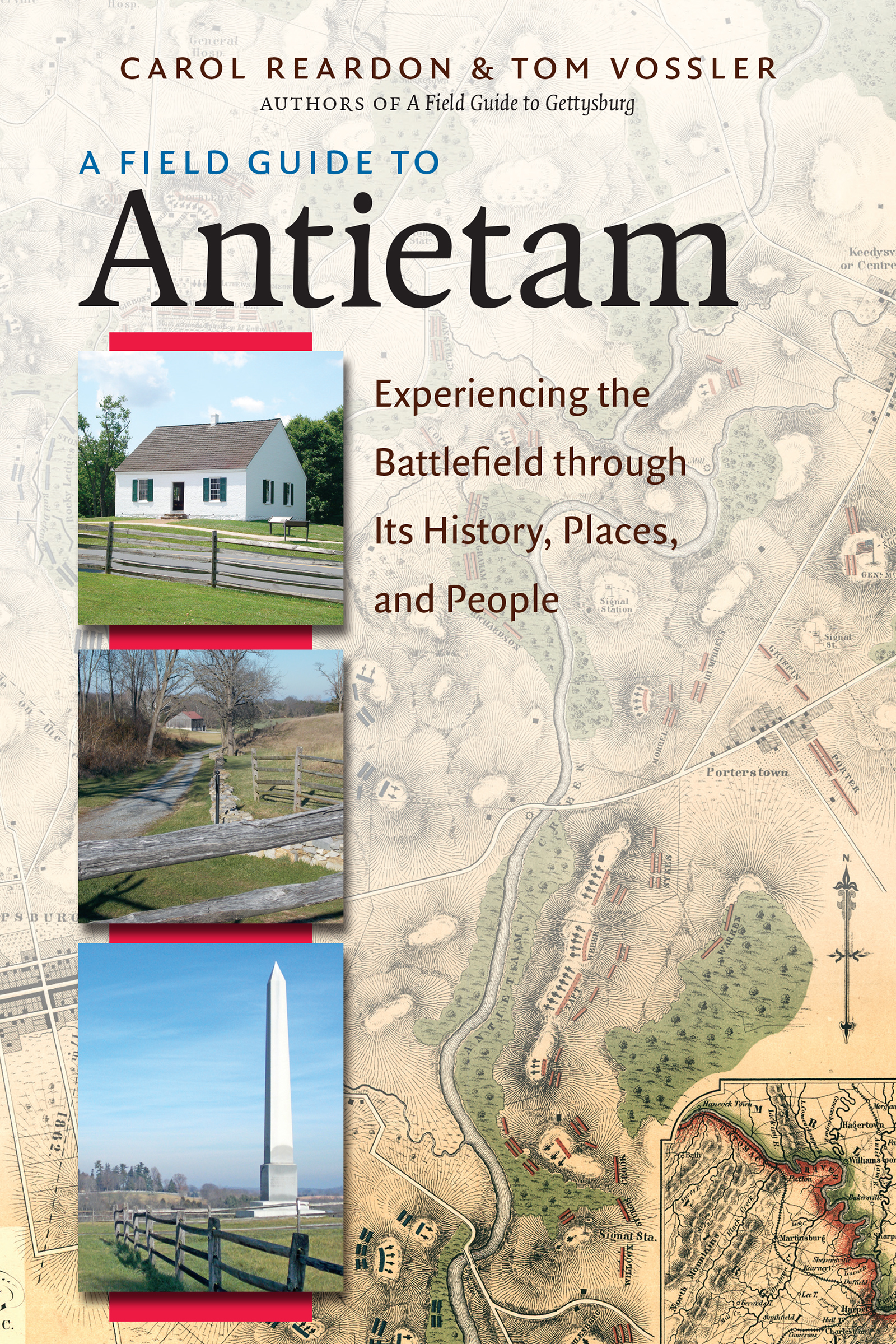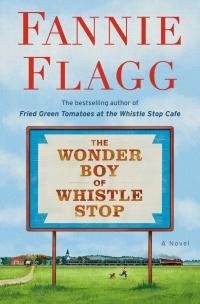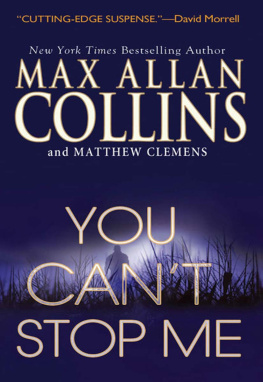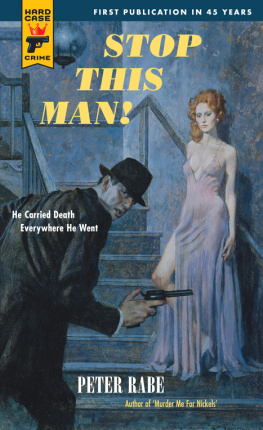Contents

A FIELD GUIDE TO Antietam
2016 THE UNIVERSITY OF NORTH CAROLINA PRESS
ALL RIGHTS RESERVED
Designed by Kimberly Bryant and set in Quadraat types by Rebecca Evans
Manufactured in the United States of America
The University of North Carolina Press has been a member of the Green Press Initiative since 2003.
Front cover: William H. Willcox, Map of the Battle of Antietam (Philadelphia: Lith. of P. S. Duval & Son, 1862), courtesy of the Library of Congress, Geography and Map Division. Back cover: author photos of the Dunker Church, the William Roulette farm and the sunken road, and the 9th New York monument with Cemetery Hill in the background. Title page illustration: Artist Thule Thulstrups interpretation of the charge of Colonel William H. Irwins brigade toward the Dunker Church (Library of Congress).
Library of Congress Cataloging-in-Publication Data
Names: Reardon, Carol, author. | Vossler, Tom, author.
Title: A field guide to Antietam : experiencing the battlefield through its history, places, and people / Carol Reardon and Tom Vossler.
Description: Chapel Hill : The University of North Carolina Press, [2016] | Includes bibliographical references and index.
Identifiers: LCCN 2016016537 | ISBN 9781469630205 (pbk : alk. paper) | ISBN 9781469630212 (ebook)
Subjects: LCSH : Antietam National Battlefield (Md.)Tours. | Antietam, Battle of, Md., 1862.
Classification: LCC E 474.65 . R 43 2016 | DDC 975.2/91dc23 LC record available at https://lccn.loc.gov/2016016537
We dedicate this book to BARBARA VOSSLER a soldiers wife for thirty years and still diligently at her post. A wise businesswoman, gracious hostess, hardworking cattlewoman, and untiring worker in her church community, she has given freely of her strength, energy, encouragement, and patience.

Contents
A FIELD GUIDE TO Antietam

Introduction
The Maryland Campaign of 1862
An Overview
The newspaper report filed on September 20, 1862, from the headquarters of the Army of the Potomac finally resolved a bit of confusion about the bloody clash of September 17: The name given to this battle is the Antietam. Few had ever heard the name before, so one newspaper spelled it Antietum, while the New York Tribune included a map that traced the course of Antistam Creek. Most Southerners followed their accepted practice of naming battles after the nearest town, so from the start they called this fight Sharpsburg.
Except in direct quotations, this guide will call this battle Antietam, not from any partisan sentiment but simply to follow the National Park Services official name for the battlefield through which this guide will take you.
When war came to western Maryland, it arrived unwelcome and unbidden. What brought General Robert E. Lees Confederate Army of Northern Virginia and Major General George B. McClellans Army of the Potomac to the rolling hills around this small town in the waning summer of 1862?
The second year of the war had started well enough for Union arms. In February, Brigadier General Ulysses S. Grant captured Fort Henry on the Tennessee River and then, in short order, hemmed in and captured a Confederate garrison of 15,000 men at Fort Donelson on the Cumberland River. A Union flotilla sailed down the Mississippi River and took Memphis, while a much larger combined army-navy venture captured New Orleans, the Confederacys largest city. Grant won a bloody two-day battle at Shiloh in April and opened the way for deeper advances into the western Confederacy. In the eastern theater, McClellan had emerged as the Unions young Napoleon with a plan to take the Confederate capital at Richmond and end the war.
By midsummer, however, the Norths dreams of military victory disappeared. After Shiloh, Grants forces bogged down in northern Mississippi around Corinth. Confederate General Braxton Bragg had organized an army in Middle Tennessee to reassert control of that agriculturally rich area and perhaps move north into Kentucky. Most worrisome, McClellans grand plan to capture Richmond ended in failure on the very outskirts of the Confederate capital after the Seven Days Battles from June 25 through July 1. McClellan insisted he had not given up on his campaignhe had merely changed his basebut a frustrated President Lincoln recalled the Army of the Potomac to Washington in August. It arrived just as Major General John Popes Army of Virginia quit its own advance upon Richmond through central Virginia and fell back to Washington in headlong retreat after Lees forces routed Pope on August 2830 on the old Bull Run battlefield of July 1861.

The 1862 Maryland Campaigns Area of Operations and Preliminary Military Actions

Brigadier General Robert E. Rodess Alabamians led the vanguard of General Robert E. Lees Army of Northern Virginia across the Potomac River into Maryland. (LOC)
The Maryland Campaign of 1862 began immediately after the Union debacle at Second Bull Run. On September 3, General Lee wrote to President Jefferson Davis, The present seems to be the most propitious time since the commencement of the war for the Confederate Army to enter Maryland. With the Union forces in Washington demoralized and disorganized and new troops raised in response to Lincolns July call for 300,000 more recruits still entirely raw, Lee believed that the time had come for the Confederacy to give material aid to Maryland and afford her an opportunity of throwing off the oppression to which she is now subject.
Over the past 150 years, historians have compiled a list of factors to explain why Lee suggested his move into Maryland, andjust as importantwhy Jefferson Davis approved it. The reasons include a number of elements clearly designed to improve the Confederate military situation in the eastern theater. Other factors touched on the Confederacys strategic requirements with social, political, or diplomatic implications well beyond their military advantage to Lees forces. The list includes such notions as the Confederacys desire to carry the war into territory loyal to the Union and exact retribution for depredations on Southern civilians; its wish to encourage Maryland to join the Confederacy and its young men to join Lees army; its need for Lees army to exploit the disorganization of the defeated Union armies; its hope to enter Pennsylvania to cut important railroads and bridges that facilitated the movement of troops and supplies between the eastern and western theaters; its desire to win victories on Northern soil to improve prospects for improved diplomatic relations with France and England when the potential for success seemed especially promising; a belief that the presence of Confederate troops on Union soil might inspire supporters of the Northern peace party in the fall elections; and its need to refill the empty Confederate quartermaster and commissary stores. This guide will focus primarily on those points that most clearly influenced Lees operations directly or those factors the actions of his army might have immediately influenced.
















